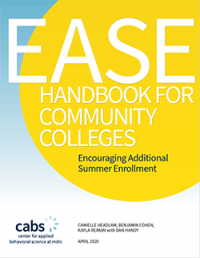The EASE Handbook for Community Colleges
Encouraging Additional Summer Enrollment

 Students who take summer courses attempt and earn more credits per year — potentially speeding up the time it takes them to graduate. This boost may be particularly beneficial for community college students, many of whom are enrolled part time. Many community college students also receive financial aid that can be applied to the cost of summer courses. Encouraging them to sign up is a low-cost way for schools to increase enrollment and improve student outcomes.
Students who take summer courses attempt and earn more credits per year — potentially speeding up the time it takes them to graduate. This boost may be particularly beneficial for community college students, many of whom are enrolled part time. Many community college students also receive financial aid that can be applied to the cost of summer courses. Encouraging them to sign up is a low-cost way for schools to increase enrollment and improve student outcomes.
This guide, the EASE Handbook for Community Colleges, is for college administrators and staff members — to help you implement two interventions designed to increase summer enrollment rates at your school. They were developed and evaluated by MDRC in partnership with the Ohio Association of Community Colleges and 10 Ohio community colleges, as part of the Encouraging Additional Summer Enrollment (EASE) project.
- Strategy 1: An informational campaign of personalized student communications using email and mail and informed by behavioral science. The campaign simplifies academic, financial aid, and procedural information related to summer enrollment, reminds students about that information, and motivates them to follow through and register for courses.
- Strategy 2: A similar informational campaign paired with a “last-dollar” tuition-assistance grant that covers the difference between each student’s summer tuition and fees and any grant financial aid (such as Pell Grant funding) they have available for summer courses.
These interventions proved effective in MDRC’s 2017/2018 randomized controlled trials — the most rigorous form of evaluation — increasing both enrollment in summer courses and credit attainment. Although they did not increase enrollment in the subsequent fall semester, the additional credits earned during the summer helped students make progress toward earning a degree.
By increasing summer enrollment, the EASE interventions also increased tuition revenue for colleges, much of which came from an increase in Pell Grant funding. A simplified return-on-investment calculation suggests that Strategy 2 generated more revenue than the program cost of the tuition assistance grant. Given these positive findings, MDRC has created The EASE Handbook for Community Colleges to help practitioners like you adopt the two strategies tested in the study.
This is not meant to be a “one size fits all” approach. Strategy 1, for example, has a lower upfront cost, does not require tuition-assistance disbursement, and has a positive return on investment. Strategy 2 has a higher upfront cost and requires tuition-assistance disbursement, but it also has simpler messaging techniques and a larger return on investment. This guide will help you determine the best fit for your school and your students.
Also included, the EASE Summer School Toolkit:
- Customizable message templates for each strategy, annotated with instructions and tips, plus an editable version without annotations you can copy and paste into your own campaign
- A summer Pell Grant calculator to estimate students’ Pell Grant awards and create personalized messages to tell them how much funding they may have available
Let’s get started!






